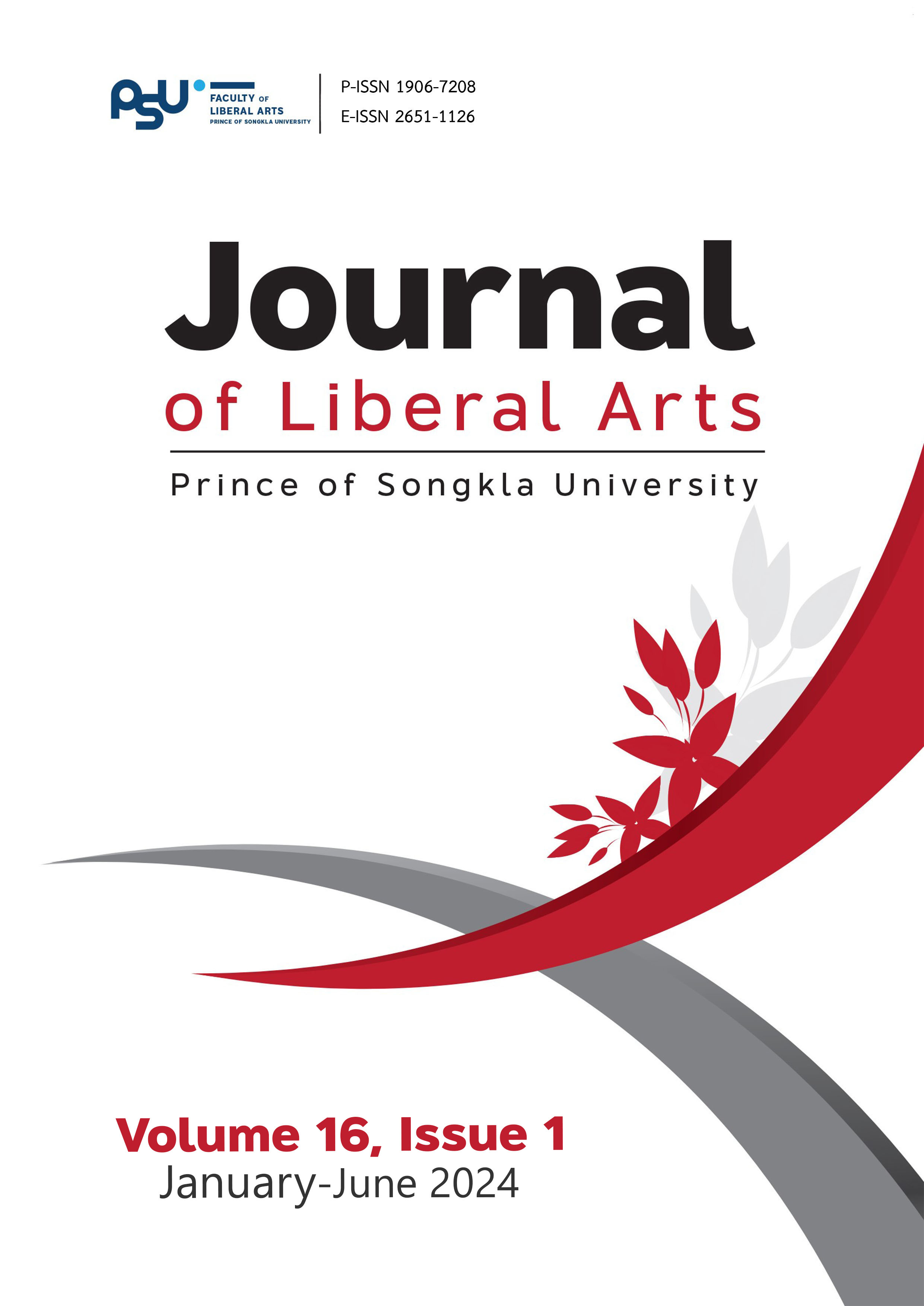การศึกษาสำนวนจีนที่มีคำว่าทอง
DOI:
https://doi.org/10.14456/jlapsu.2024.2คำสำคัญ:
ทอง, ภาษาจีน, สำนวน, อุปลักษณ์บทคัดย่อ
สำนวนคือวลีหรือคำพูดที่แต่งขึ้นในเชิงอุปลักษณ์ แฝงเร้นความหมายลึกซึ้ง ไม่สามารถถอดความด้วยการแปลคำแต่ละคำตามตัวอักษรโดยตรง สำนวนที่มีใช้สืบทอดกันมาช้านานในแต่ละภาษาล้วนเป็นมรดกทางวัฒนธรรมอันล้ำค่าสำหรับผู้ใช้ภาษานั้น ๆ เนื่องจากสามารถสะท้อนให้เห็นถึงความคิด ความเชื่อของคนในสังคม นับแต่อดีตมา คนจีนมักใช้สำนวนในการสื่อสารในชีวิตประจำวัน สำนวนหลายสำนวนได้มาจากสภาพแวดล้อมธรรมชาติและสอดคล้องกับความเชื่อของจีนโบราณเกี่ยวกับธาตุทั้งห้า ได้แก่ ดิน น้ำ ไฟ ไม้ และโลหะ ซึ่งถือเป็นองค์ประกอบพื้นฐานของทุกสิ่งในโลก เนื่องจากทองเป็นตัวแทนของความล้ำค่า ซึ่งมักเกี่ยวข้องกับความเชื่อบางประการในวัฒนธรรมจีน บทความนี้จึงมุ่งศึกษาวิเคราะห์สำนวนที่มีคำว่า “jin” (金) เพื่อเข้าใจความหมายเชิงอุปลักษณ์ ตลอดจนความเชื่อ ค่านิยม และประเด็นอื่น ๆที่เกี่ยวข้อง ซึ่งผลการวิจัยพบว่า สำนวนที่มีคำว่า “jin” ที่รวบรวมจากพจนานุกรมสำนวนจีน 8 เล่มมีทั้งหมด 411 สำนวน ให้ความหมายเชิงอุปลักษณ์ได้ทั้งสิ้น 414 ความหมายและสามารถจัดแบ่งเป็น 9 กลุ่ม ได้แก่ มนุษย์ ความล้ำค่า ความงาม เงินทองของมีค่า สถานะและมาตรฐานทางสังคม ความดีงาม ความมั่นคงและความแข็งแกร่ง ธรรมชาติ และความหมายอื่น ๆ ทั้งนี้สำนวนจีนที่มีคำว่า “jin” ยังสามารถช่วยให้เราเข้าใจสังคมจีนในอดีต รวมถึงค่านิยม วัฒนธรรม พิธีกรรมและความเชื่อของชาวจีนได้อีกด้วย
References
Chen, J. (1986). Yin Yang Wuxing Babu Qiyuan Xinshuo (in Chinese) [A new theory of the origin of the five elements of Yin yang]. Studies in the History of Natural Sciences, 5(2),97-112. https://kns.cnki.net/kcms2/article/abstract?v=3uoqIhG8C44YLTlOAiTRKqd0WnNPv0wTDjtDUwHroNxgjGwOdF8RaTDfBuBEXguNGI4b_N0ATFVprCi_mMBcR5JLdSbdgq2v&uniplatform=NZKPT
Dictionary Editing Office Institute of Linguistics Chinese Academy of Sciences. (1996). Xiandai Hanyu Cidian (3th ed) (in Chinese) [Modern Chinese dictionary]. The Commercial Press.
Fang, H. (2013). Qingdai Manzu de Jing Ya Wenhua (in Chinese) [The crow culture of the Manchus in the Qing Dynasty]. Gansu Ethnic Studies, 2013(2), 86-90.
Lakoff, G., & Johnson, M. (1980). Metaphors we live by. Chicago University Press.
Language Research Institute of Hubei University. (2004). Hanyu Chengyu Da Cidian (in Chinese) [Chinese idioms dictionary]. Zhonghua Book Company.
Lexicographical Center of Commercial Press. (2015). Xinhua Chengyu Cidian (in Chinese) [Xinhua idioms dictionary]. The Commercial Press.
Li, X. (2006). Xiandai Hanyu Chengyu Guifan Da Cidian (in Chinese) [Modern Chinese standard idioms dictionary]. Changchun Publishing House
Liu, J. (2012). Hanyu Chengyu Jinghua Cidian (Baipi) (in Chinese) [Chinese idioms essence dictionary (white)]. Kaiming Publishing House.
Luo, Z. (1986). Hanyu Da Cidian (in Chinese) [Grand Chinese dictionary]. Hanyu Dacidian Chubanshe.
Song, Y. (2017). Hanyu Chengyu Cidian (in Chinese) [Chinese idioms dictionary]. Sichuan Lexicographical Press.
Wang, J. & Chen, Y. (2015). Jiyu Yuliaoku de Zhongguo Chuantong Zhexue Shuyu “Wuxing” Yinyu Fanyi yu Duiwai Hanyu Jiaoxue Yanjiu (in Chinese) [Translation of the metaphor of the traditional Chinese philosophical term "Five Elements" based on corpus and research on teaching Chinese as a foreign language]. Journal of Dalian University 36(6), 139-143. https://kns.cnki.net/kcms2/article/abstract?v=3uoqIhG8C44YLTlOAiTRKibYlV5Vjs7ijP0rjQDAVm8oHBO0FTadrZLl_Ipm5LyqMe6FnaHagErledaPQvjS86sEm8ZZmpB&uniplatform=NZKPT.
Wang, S., & Sun, Y. (2010). “Jin” Ciqun zhong Chengyu de Yinyu Renzhi Fenxi. (in Chinese) [Metaphorical cognitive analysis of idioms in the "gold" word group]. Journal of Anhui Literature, 2010(12), 242-243. https://kns.cnki.net/kcms2/article/abstract?v=3uoqIhG8C44YLTlOAiTRKgchrJ08w1e7_IFawAif0my9J275rTFshgZNvF_XnQiYD_DR5yRTamKojo7aMWe5AY6w90IOM9Q&uniplatform=NZKPT
Wang, X. (2017). Hanyu Chengyu Da Cidian (in Chinese) [Chinese idioms dictionary]. Sinolingua Press.
Wei, Y. (2018). A study on the Metaphor of “Gold” in Chinese idioms. Southwest University. https://kns.cnki.net/kcms2/article/abstract?v=2KdPcD7ewrS11XtuYOYWgZGu_ukI88lfERdH2b0LfJYM_DxDV5xC2klB_STNfVwSBSBSPaqzXynVlD5oSTtt6myJ73SiOM7zvghmKKWXDVbN2FiGLDxdg==&uniplatform=NZKPT&language=gb
Xu, G. (2009). Yin Yang Wuxing Zhexue Guannian dui Zhongguo Chuantong Yinshi Wenhua de Yingxiang (in Chinese) [The influence of the philosophical concept of yin and yang and the five elements on traditional Chinese food culture]. New West Journal, 2009 (09), 135-136. https://kns.cnki.net/kcms2/article/abstract?v=3uoqIhG8C44YLTlOAiTRKgchrJ08w1e75TZJapvoLK2mqDPZWAthiDRhFYDG3hN3In5heJ9iIXikh
Bb544W7yHfyzcJK_P&uniplatform=NZKPT
Xu, H. (2011). Jinzi Wenhua dui Zhongguo Kuaiji Wenhua Jianshe de Gongxian (in Chinese) [The contribution of the “gold” character culture to the construction of China's accounting culture]. Journal of Inner Mongolia University of Electricity, 2011(125), 14-15. https://doi.org/10.16162/j.issn.1672-3473.2011.01.038
Yi, M. (2010). Gudai Yueqihua Bayin (in Chinese) [Eight tones of ancient musical instru-ments]. Guoxue, 2010(4), 78-80. https://kns.cnki.net/kcms2/article/abstract?v=3uoqIhG8C44YLTlOAiTRKgchrJ08w1e7_IFawAif0myv4JBlAN9nd2r0igGYEDXMGQ1I6LBx-gO0IFC2wOV1uqK7crxILuND&uniplatform=NZKPT.
Yuan, K. (1998). Zhongguo Shenhua Chuanshuo (in Chinese) [Chinese myths and legends].214 People's Literature Publishing House
Zhang, L. (2010). Wuxing guan dui Zhongguo gudai renxue sixiang de yingxiang (in Chinese) [The influence of the Five Elements on ancient Chinese anthropological thought]. Journal of Liaoning University (Philosophy and Social Science), 38(2), 1-7. https://kns.cnki.net/kcms2/article/abstract?v=3uoqIhG8C44YLTlOAiTRKgchrJ08w1e7_IFawAif0mxyjUStHz4nG-l2RjDhjdM5FFeBxkpmiIzE7paIzWv9Z8AmvDZbHv1K&uniplatform=NZKPT
Zhang, Y., & Ma, Q. (2018). Wuxing Wenhua dui Yishu Sheji de Yingxiang Chutan (in Chinese) [A preliminary study on the influence of the Five Elements culture on art design].
Space Art Journal, 2018(1), 50-53. https://doi.org/10.13337/j.cnki.packaging.world.2018.01.008
Zhao, J., Zhang, Y., & Tan, L. (2013). Zhonghua Chengyu Da Cidian (in Chinese) [Zhonghua idioms dictionary]. Sinolingua Press.
Downloads
เผยแพร่แล้ว
How to Cite
ฉบับ
บท
License
Copyright (c) 2024 Pimpan Jantondaeng, Zheng Zezhi

This work is licensed under a Creative Commons Attribution-NonCommercial-NoDerivatives 4.0 International License.
ลิขสิทธิ์บทความเป็นของผู้เขียน แต่วารสารศิลปศาสตร์ มหาวิทยาลัยสงขลานครินทร์ ขอสงวนสิทธิ์ในการเป็นผู้ตีพิมพ์เผยแพร่เป็นครั้งแรก




